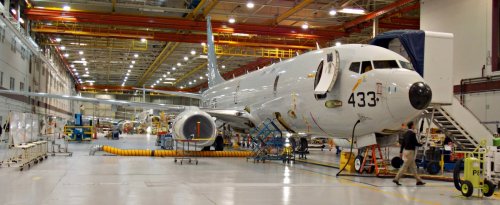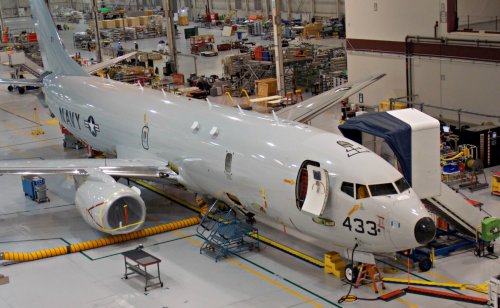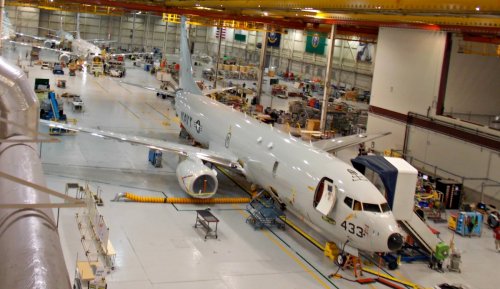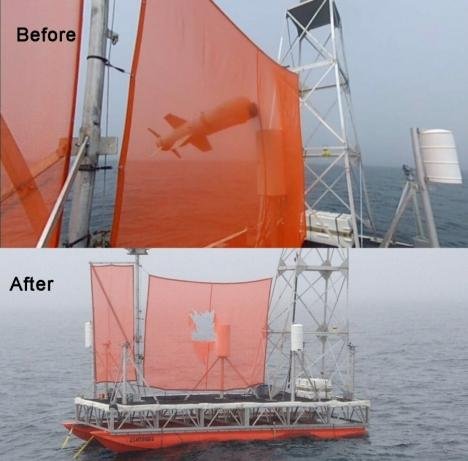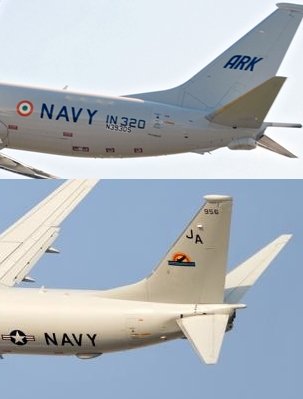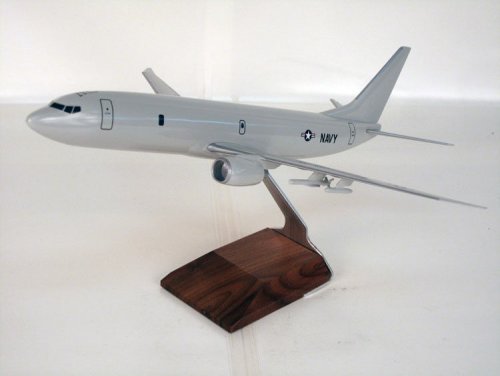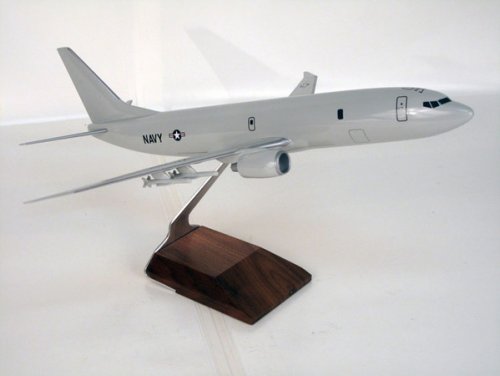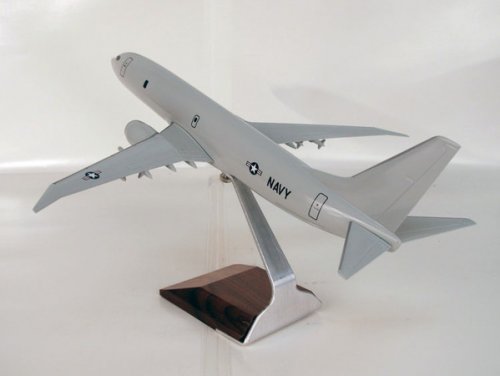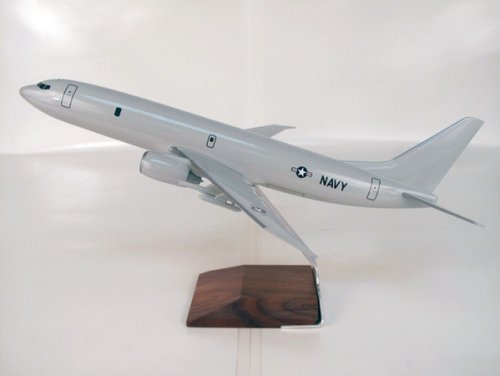You are using an out of date browser. It may not display this or other websites correctly.
You should upgrade or use an alternative browser.
You should upgrade or use an alternative browser.
Boeing P-8A Poseidon (737-800EFV) MMA (Multi-mission Maritime Aircraft)
- Thread starter hesham
- Start date
seruriermarshal
ACCESS: Top Secret
- Joined
- 4 May 2008
- Messages
- 1,180
- Reaction score
- 574
One of NAVAIR’s P-8A Poseidon's has successfully launched a Harpoon AGM-84D Block IC missile during a live fire exercise in California at the Point Mugu Sea Test Range.
Richard Benedikz - 11-Jul-2013
The missile scored a direct hit on a modular target on the first hot run.
The U.S. Navy announced on July 1 in an Initial Operational Test and Evaluation report that the P-8A Poseidon was ready for fleet introduction.”
Last month, the Harpoon was fired from the P-8A, resulting in a successful target strike.
With the program passing IOT&E, the P-8A program is on track for an initial operational deployment this winter when the first P-8A squadron will deploy with P-3 and EP-3 squadrons.
To date, nine low rate production aircraft have been delivered to the fleet and six test aircraft have been delivered to NAVAIR. According to the program of records, the Navy plans to purchase 117 P-8A’s that will replace the P-3C Orion as a long-range anti-submarine warfare, intelligence, surveillance and reconnaissance aircraft.
Top photo: A Harpoon AGM-84D Block IC missile, which was released from a P-8A Poseidon (not visible), directly hits a Low Cost Modular Target (LCMT)at the Point Mugu Sea Test Range in California June 24. Bottom photo: A LCMT at the Point Mugu Sea Test Range is shown after the Harpoon successfully strikes it. (U.S. Navy photos)
http://www.key.aero/view_article.asp?ID=6460&thisSection=military
Richard Benedikz - 11-Jul-2013
The missile scored a direct hit on a modular target on the first hot run.
The U.S. Navy announced on July 1 in an Initial Operational Test and Evaluation report that the P-8A Poseidon was ready for fleet introduction.”
Last month, the Harpoon was fired from the P-8A, resulting in a successful target strike.
With the program passing IOT&E, the P-8A program is on track for an initial operational deployment this winter when the first P-8A squadron will deploy with P-3 and EP-3 squadrons.
To date, nine low rate production aircraft have been delivered to the fleet and six test aircraft have been delivered to NAVAIR. According to the program of records, the Navy plans to purchase 117 P-8A’s that will replace the P-3C Orion as a long-range anti-submarine warfare, intelligence, surveillance and reconnaissance aircraft.
Top photo: A Harpoon AGM-84D Block IC missile, which was released from a P-8A Poseidon (not visible), directly hits a Low Cost Modular Target (LCMT)at the Point Mugu Sea Test Range in California June 24. Bottom photo: A LCMT at the Point Mugu Sea Test Range is shown after the Harpoon successfully strikes it. (U.S. Navy photos)
http://www.key.aero/view_article.asp?ID=6460&thisSection=military
Attachments
"Boeing Surveillance Plane Not Yet Effective, U.S. Tester Finds"
by Tony Capaccio January 23, 2014
Source:
http://www.businessweek.com/news/2014-01-23/boeing-surveillance-plane-found-not-yet-effective-for-missions
by Tony Capaccio January 23, 2014
Source:
http://www.businessweek.com/news/2014-01-23/boeing-surveillance-plane-found-not-yet-effective-for-missions
A new Boeing Co. (BA:US) surveillance aircraft deployed to Japan last month isn’t yet effective at hunting submarines or performing reconnaissance over large areas -- two of its main missions, the Pentagon’s weapons tester found.
Flaws in the $35 billion program included the plane’s radar performance, sensor integration and data transfer, Michael Gilmore, chief of the Pentagon testing office, wrote in his annual report on major weapons, which has yet to be released. He said the new P-8A Poseidon exhibited “all of the major deficiencies” identified in earlier exercises when subjected to more stressful realistic combat testing from September 2012 to March 2013.
“Many of these deficiencies” led Gilmore to determine that the P-8A “is not effective for the intelligence, surveillance and reconnaissance mission and is not effective for wide area anti-submarine search,” he said in a section of the report obtained by Bloomberg News. The Navy plans to conduct additional testing “to verify the correction of some deficiencies,” he wrote.
Gilmore’s conclusions suggest the initial aircraft in the program -- which packs a modified Boeing 737-800 with radar and sensors -- aren’t ready for deployment. Among its primary missions is tracking Chinese submarines. Six of the planes have been deployed to Japan supporting 7th Fleet maritime patrol operations at Naval Air Facility Atsugi as part of the U.S. strategic pivot to the Asia-Pacific region.
Vice Admiral Robert Thomas, commander of the 7th Fleet, said in a Jan. 10 press release that the aircraft “represents a significant improvement” over the older P-3 Orion from Lockheed Martin Corp. (LMT:US), “providing the opportunity to detect, track and report on more targets than ever before.”
Delivered 13
Chicago-based Boeing last month delivered the 13th of what’s to be a 113-aircraft program. The Navy in November declared the aircraft ready for combat deployment after determining the criteria for performing effective patrols “were fully met,” Lieutenant Caroline Hutcheson, a Navy spokeswoman, said in a telephone interview.
“The P-8A was ready, was needed in theater and continues to more than meet fleet commanders’ expectations,” she said. Hutcheson said Gilmore’s office has “consistently highlighted both effective warfare areas as well as recommendations for areas to re-visit.”
“Most issues cited have been collectively identified,” and the Navy has developed “software upgrades to correct deficiencies,” she said.
Boeing spokesman Charles Ramey said in an e-mailed statement that he hadn’t seen Gilmore’s report and was unable to comment directly.
Boeing’s Comment
“Feedback we’ve received to date is that the Navy is very happy with the P-8A’s performance,” he said. “As always, Boeing will work hand in hand with the Navy to support any issues that come up.”
Defense Secretary Chuck Hagel, during a trip to Japan in October, lauded the P-8A’s “cutting-edge technologies.”
Gilmore spokeswoman Jennifer Elzea said the test office concluded the aircraft was effective in providing small-area searches similar to the P-3C Orion it’s replacing.
The aircraft also is effective in conducting “unarmed anti-surface warfare missions,” and its radar and supporting sensors “provide an effective, all-weather surface target search,” she said in an e-mailed statement.
Gilmore’s office also concluded the airframe is reliable, offering “significant improvements in hardware reliability, maintainability and availability” over the P-3C, she said. Overall, the Boeing system “provides increased range, payload and speed,” she said.
Raytheon Radar
Gilmore’s report said the recent realistic combat testing confirmed earlier results on flaws in the P-8’s radar “and revealed the operational implications of the radar’s limitations for some targets.” It said details are classified. Raytheon Co. makes the ocean and land-surveillance radar.
Deficiencies with on-board electronics to detect enemy anti-aircraft radar “limited threat detection” while “seriously degrading capabilities and aircraft survivability across all major missions,” the report found. Northrop Grumman Corp (NOC:US) makes the “Electronic Support Measures” equipment.
Elzea said the Navy is conducting additional testing “to evaluate several system technical improvements” that will be assessed by Gilmore’s office “as they are delivered.”
The Navy has plans for fielding two sets of aircraft upgrades to “improve anti-submarine warfare capability over several years” and has developed “an adequate test and evaluation master plan” to evaluate improvements, she said.
To contact the reporter on this story: Tony Capaccio in Washington at acapaccio@bloomberg.net
To contact the editor responsible for this story: John Walcott at jwalcott9@bloomberg.net
seruriermarshal
ACCESS: Top Secret
- Joined
- 4 May 2008
- Messages
- 1,180
- Reaction score
- 574
Boeing Receives $2.4 Billion Contract for 16 P-8A Poseidon Aircraft
US Navy orders 1st full-rate production lot
SEATTLE, Feb. 26, 2014 -- Boeing's [NYSE: BA] P-8A Poseidon program will enter full production, following a $2.4 billion contract award from the U.S. Navy for 16 additional aircraft that will bolster maritime patrol capabilities.
The order, which will take the total fleet to 53, marks a transition from preliminary low-rate production.
Boeing has delivered 13 P-8As to the Navy, which deployed its first patrol squadron to Kadena, Japan in December 2013 and has been conducting operational missions since then.
"This milestone is a testament to the incredible effort and dedication of the team to deliver the P-8A to the fleet as planned," Navy P-8A program manager Capt. Scott Dillon said. "The future of the Maritime Patrol and Reconnaissance community has begun to make history with the P-8As already delivered to the fleet. These full-rate production aircraft will give us the opportunity to deliver the best system through a cost-effective procurement contract."
Based on Boeing's Next-Generation 737-800 commercial airplane, the P-8A will enhance the service's anti-submarine, anti-surface warfare and intelligence, surveillance and reconnaissance capabilities. Overall, the Navy plans to purchase 117 P-8As to replace its P-3 fleet.
"This contract reflects the success of the program and enables us to continue delivering an advanced, cost-effective maritime patrol aircraft to the Navy," added Rick Heerdt, Boeing vice president and P-8 program manager. "We delivered eight P-8s, all on or ahead of schedule in 2013, and we intend to keep that streak going in 2014."
Boeing assembles the P-8A aircraft in the same facility where it builds all its 737 aircraft. The Poseidon team uses a first-in-industry in-line production process that draws on Boeing's Next-Generation 737 system and has resulted in cost and schedule savings.
Boeing's industry team includes CFM International, Northrop Grumman, Raytheon, Spirit AeroSystems, BAE Systems and GE Aviation.
http://boeing.mediaroom.com/Boeing-Receives-2-4-Billion-Contract-for-16-P-8A-Poseidon-Aircraft
US Navy orders 1st full-rate production lot
SEATTLE, Feb. 26, 2014 -- Boeing's [NYSE: BA] P-8A Poseidon program will enter full production, following a $2.4 billion contract award from the U.S. Navy for 16 additional aircraft that will bolster maritime patrol capabilities.
The order, which will take the total fleet to 53, marks a transition from preliminary low-rate production.
Boeing has delivered 13 P-8As to the Navy, which deployed its first patrol squadron to Kadena, Japan in December 2013 and has been conducting operational missions since then.
"This milestone is a testament to the incredible effort and dedication of the team to deliver the P-8A to the fleet as planned," Navy P-8A program manager Capt. Scott Dillon said. "The future of the Maritime Patrol and Reconnaissance community has begun to make history with the P-8As already delivered to the fleet. These full-rate production aircraft will give us the opportunity to deliver the best system through a cost-effective procurement contract."
Based on Boeing's Next-Generation 737-800 commercial airplane, the P-8A will enhance the service's anti-submarine, anti-surface warfare and intelligence, surveillance and reconnaissance capabilities. Overall, the Navy plans to purchase 117 P-8As to replace its P-3 fleet.
"This contract reflects the success of the program and enables us to continue delivering an advanced, cost-effective maritime patrol aircraft to the Navy," added Rick Heerdt, Boeing vice president and P-8 program manager. "We delivered eight P-8s, all on or ahead of schedule in 2013, and we intend to keep that streak going in 2014."
Boeing assembles the P-8A aircraft in the same facility where it builds all its 737 aircraft. The Poseidon team uses a first-in-industry in-line production process that draws on Boeing's Next-Generation 737 system and has resulted in cost and schedule savings.
Boeing's industry team includes CFM International, Northrop Grumman, Raytheon, Spirit AeroSystems, BAE Systems and GE Aviation.
http://boeing.mediaroom.com/Boeing-Receives-2-4-Billion-Contract-for-16-P-8A-Poseidon-Aircraft
- Joined
- 26 May 2006
- Messages
- 34,863
- Reaction score
- 15,727
seruriermarshal said:Boeing Receives $2.4 Billion Contract for 16 P-8A Poseidon Aircraft
US Navy orders 1st full-rate production lot
SEATTLE, Feb. 26, 2014 -- Boeing's [NYSE: BA] P-8A Poseidon program will enter full production, following a $2.4 billion contract award from the U.S. Navy for 16 additional aircraft that will bolster maritime patrol capabilities.
The order, which will take the total fleet to 53, marks a transition from preliminary low-rate production.
Boeing has delivered 13 P-8As to the Navy, which deployed its first patrol squadron to Kadena, Japan in December 2013 and has been conducting operational missions since then.
"This milestone is a testament to the incredible effort and dedication of the team to deliver the P-8A to the fleet as planned," Navy P-8A program manager Capt. Scott Dillon said. "The future of the Maritime Patrol and Reconnaissance community has begun to make history with the P-8As already delivered to the fleet. These full-rate production aircraft will give us the opportunity to deliver the best system through a cost-effective procurement contract."
Based on Boeing's Next-Generation 737-800 commercial airplane, the P-8A will enhance the service's anti-submarine, anti-surface warfare and intelligence, surveillance and reconnaissance capabilities. Overall, the Navy plans to purchase 117 P-8As to replace its P-3 fleet.
"This contract reflects the success of the program and enables us to continue delivering an advanced, cost-effective maritime patrol aircraft to the Navy," added Rick Heerdt, Boeing vice president and P-8 program manager. "We delivered eight P-8s, all on or ahead of schedule in 2013, and we intend to keep that streak going in 2014."
Boeing assembles the P-8A aircraft in the same facility where it builds all its 737 aircraft. The Poseidon team uses a first-in-industry in-line production process that draws on Boeing's Next-Generation 737 system and has resulted in cost and schedule savings.
Boeing's industry team includes CFM International, Northrop Grumman, Raytheon, Spirit AeroSystems, BAE Systems and GE Aviation.
http://boeing.mediaroom.com/Boeing-Receives-2-4-Billion-Contract-for-16-P-8A-Poseidon-Aircraft
Good news.
And from last week:
Funny how these headlines and articles characterize the P-8 Poseidon as a "spy plane."
"Abbott Government to buy eight new Boeing P-8A Poseidon spy planes"
http://www.news.com.au/national/abbott-government-to-buy-eight-new-boeing-p8a-poseidon-spy-planes/story-fncynjr2-1226833661509
"UPDATE 1-Boeing wins $2.1 billion contract for 16 more P-8 spy planes"
http://www.reuters.com/article/2014/02/25/boeing-poseidon-idUSL1N0LU2CE20140225
"Abbott Government to buy eight new Boeing P-8A Poseidon spy planes"
http://www.news.com.au/national/abbott-government-to-buy-eight-new-boeing-p8a-poseidon-spy-planes/story-fncynjr2-1226833661509
"UPDATE 1-Boeing wins $2.1 billion contract for 16 more P-8 spy planes"
http://www.reuters.com/article/2014/02/25/boeing-poseidon-idUSL1N0LU2CE20140225
- Joined
- 3 October 2007
- Messages
- 1,960
- Reaction score
- 1,195
Triton said:Funny how these headlines and articles characterize the P-8 Poseidon as a "spy plane."
That's OK, I watched the crawl on one of the cable news networks explain that the P-8 spy plane was the replacement for the P-3 spy plane... at least they're consistent!
F-14D said:Triton said:Funny how these headlines and articles characterize the P-8 Poseidon as a "spy plane."
That's OK, I watched the crawl on one of the cable news networks explain that the P-8 spy plane was the replacement for the P-3 spy plane... at least they're consistent!
In fairness, the only P-3 that's really penetrated into the public consciousness is the EP-3 Aries brought down in China a few years ago.
- Joined
- 3 October 2007
- Messages
- 1,960
- Reaction score
- 1,195
Triton said:"UPDATE 1-Boeing wins $2.1 billion contract for 16 more P-8 spy planes"
http://www.reuters.com/article/2014/02/25/boeing-poseidon-idUSL1N0LU2CE20140225
FY15 buy cuts this in half
FighterJock
ACCESS: Above Top Secret
- Joined
- 29 October 2007
- Messages
- 5,594
- Reaction score
- 5,916
So when will the RAF be getting some to replace the much missed Nimrod?
Madurai said:In fairness, the only P-3 that's really penetrated into the public consciousness is the EP-3 Aries brought down in China a few years ago.
That might be the case in the USA but in Australia they have had far more recognition for their search and rescue operation involvement over the years.
- Joined
- 2 January 2006
- Messages
- 659
- Reaction score
- 283
FighterJock said:So when will the RAF be getting some to replace the much missed Nimrod?
Most likely post 2020 if they go with it, i suspect they will do a requirement in the 2015 SDSR and probably come up with a mixed solution like Australia with a force of P-8 and Global Hawks or similar UAV
- Joined
- 26 May 2011
- Messages
- 2,318
- Reaction score
- 3,469
Geoff_B said:FighterJock said:So when will the RAF be getting some to replace the much missed Nimrod?
Most likely post 2020 if they go with it, i suspect they will do a requirement in the 2015 SDSR and probably come up with a mixed solution like Australia with a force of P-8 and Global Hawks or similar UAV
Don't be daft Geoff. They'll order 12 off-the-shelf Airbus A319s, hang four engines on the wings, or stick one of a different type in the tail, cut loads of holes in the airframe to accommodate old British kit, rewrite the entire software suite in COBOL, change the requirement so that, due to the newly discovered phenomenon of ETOPS, only two engines are required, cut the order to 8, then after 10 years discover its costs have overrun spectacularly, cancel it and buy 6 mothballed Aussie Orions.
- Joined
- 25 June 2009
- Messages
- 14,750
- Reaction score
- 6,113
CJGibson said:They'll order 12 off-the-shelf Airbus A319s, hang four engines on the wings, or stick one of a different type in the tail, cut loads of holes in the airframe to accommodate old British kit, rewrite the entire software suite in COBOL, change the requirement so that, due to the newly discovered phenomenon of ETOPS, only two engines are required, cut the order to 8, then after 10 years discover its costs have overrun spectacularly, cancel it and buy 6 mothballed Aussie Orions.
It's great to see we have such apt experts of military procurement among our distinguished members! ;D
- Joined
- 2 January 2006
- Messages
- 659
- Reaction score
- 283
Seriously though the MPA requirement is up for review in 2015 we have had 5 years of a capability gap with the skill levels being maintained via Project Seedcorn to place UK MPA specialists with allied forces MPA capability. Funding for seedcorn expires after 2015 so they have to make a decision to cancel the lot and say farewell to the capability, fund seedcorn for another 5 years and let the next SDSR decide in 2020 or implement a project to restore our MPA capability in one form or another. P-8A is the best case, would like option, none is the worst case and any number of ad-hoc solutions will be in the offing between these two.
- Joined
- 26 May 2011
- Messages
- 2,318
- Reaction score
- 3,469
I was being serious. Jokes about MoD procurement are no laughing matter.
See:
http://www.secretprojects.co.uk/forum/index.php/topic,15269.msg179684.html#msg179684
reply 11
And the 4-engine Mini-Bus MR turned up again in the SR(A).420/RMPA discussions.
Chris
See:
http://www.secretprojects.co.uk/forum/index.php/topic,15269.msg179684.html#msg179684
reply 11
And the 4-engine Mini-Bus MR turned up again in the SR(A).420/RMPA discussions.
Chris
- Joined
- 3 June 2006
- Messages
- 3,094
- Reaction score
- 3,949
Published on Jul 15, 2014
The Unites States Navy's P-8A Poseidon maritime patrol aircraft took flight over the Farnborough audience.
http://youtu.be/kQbYoBoRjQU
The Unites States Navy's P-8A Poseidon maritime patrol aircraft took flight over the Farnborough audience.
http://youtu.be/kQbYoBoRjQU
- Joined
- 17 October 2006
- Messages
- 2,393
- Reaction score
- 1,196
MAD was ditched because the Navy expects to do the majority of its future ASW work from high altitude (>15000 feet). Whether this is because the new multistatic active coherent (MAC) acoustics system and the radar work so well, or because the P-8A has mediocre endurance at low altitude, or a little of both, is not clear. It was advertised as a weight-saving measure but MAD is not very heavy.
- Joined
- 4 May 2008
- Messages
- 2,439
- Reaction score
- 762
For a while there was a program aimed at designing an air-droppable UAV (WBBL, Wing and Bomb Bay Launched Unmanned Air Vehicle). Two companies were competing, Piasecki and someone else, can't remember [these guys http://www.acuitytx.com/pdf/AT-3%20Press%20Release.pdf].
Here's the Piasecki Turais:
http://www.navaldrones.com/Turais.html
I remember vaguely that one of the payloads was MAD. I think the weapons bay of the P-8 was made shorter in depth, which also impacted the similar HAAWC weapons deployment program.
http://www.gizmag.com/go/7344/
Maybe the Turais doesn't fit in there anymore? that would still leave the wing racks open. Anyway, I haven't heard anything about it in years. I'm not sure that the whole concept of an expendable UAV carrying expensive sensors makes sense.
Here's the Piasecki Turais:
http://www.navaldrones.com/Turais.html
I remember vaguely that one of the payloads was MAD. I think the weapons bay of the P-8 was made shorter in depth, which also impacted the similar HAAWC weapons deployment program.
http://www.gizmag.com/go/7344/
Maybe the Turais doesn't fit in there anymore? that would still leave the wing racks open. Anyway, I haven't heard anything about it in years. I'm not sure that the whole concept of an expendable UAV carrying expensive sensors makes sense.
- Joined
- 16 April 2008
- Messages
- 9,600
- Reaction score
- 14,468
There is a fairly recent Navy SBIR for a small expendable UAV with a low-cost MAD that could be launched from sonobouy tubes. Target was less than 39 pounds (in its storage canister) and with a cost of less than $5,000 when purchased in quantity.
http://www.navysbir.com/n14_1/N141-014.htm
Boeing was offering a larger vehicle called MagEagle - a version of the Compressed Carriage ScanEagle. Two would fit in a launch pod that would hang on one of the P-8A's underwing pylons and fly for up to 24 hours before notionally being recovered on a surface ship or land base.
http://www.boeing.com/advertising/bma/se/se_01.html
http://www.navysbir.com/n14_1/N141-014.htm
Boeing was offering a larger vehicle called MagEagle - a version of the Compressed Carriage ScanEagle. Two would fit in a launch pod that would hang on one of the P-8A's underwing pylons and fly for up to 24 hours before notionally being recovered on a surface ship or land base.
http://www.boeing.com/advertising/bma/se/se_01.html
Boeing P-8 Poseidon model manufactured by Pacmin found on eBay.
Source:
http://www.ebay.com/itm/PACMIN-Pacific-Miniatures-1-100-scale-U-S-Navy-P-8-Model-/171499999433?pt=LH_DefaultDomain_0&hash=item27ee3250c9
Source:
http://www.ebay.com/itm/PACMIN-Pacific-Miniatures-1-100-scale-U-S-Navy-P-8-Model-/171499999433?pt=LH_DefaultDomain_0&hash=item27ee3250c9
Attachments
- Joined
- 9 October 2009
- Messages
- 21,938
- Reaction score
- 13,567
http://edition.cnn.com/2015/05/20/politics/south-china-sea-navy-flight/index.html
- Joined
- 21 May 2006
- Messages
- 3,002
- Reaction score
- 2,270
GTX said:And from last week:
Interested on your perspective of this purchase mate!
If not here, then PM me
Regards
Pioneer
bring_it_on
I really should change my personal text
- Joined
- 4 July 2013
- Messages
- 3,651
- Reaction score
- 3,781
The Navy's P-8 Poseidon Spotted Packing Mysterious New Pod
http://foxtrotalpha.jalopnik.com/the-navys-p-8-poseidon-spotted-packing-mysterious-new-p-1718488424

http://foxtrotalpha.jalopnik.com/the-navys-p-8-poseidon-spotted-packing-mysterious-new-p-1718488424

Well, N782DS is a P-8I for the Indian Navy. A detachable ELINT/SIGINT package would make sense...not just for Indian P-8s.
Published on Aug 20, 2015
US Navy’s P-8A Poseidon maritime patrol aircraft
https://youtu.be/0f8V1SSH1LI
US Navy’s P-8A Poseidon maritime patrol aircraft
https://youtu.be/0f8V1SSH1LI
"MoD sinks £2bn sub-hunter jet deal"
Mark Hookham and Tim Ripley Published: 1 November 2015
Source:
http://www.thesundaytimes.co.uk/sto/news/uk_news/article1627241.ece?CMP=OTH-gnws-standard-2015_10_31
Mark Hookham and Tim Ripley Published: 1 November 2015
Source:
http://www.thesundaytimes.co.uk/sto/news/uk_news/article1627241.ece?CMP=OTH-gnws-standard-2015_10_31
THE Ministry of Defence is understood to have dropped a £2bn plan to buy a fleet of US-made submarine-hunting jets for the RAF.
The proposed purchase of up to nine P-8 Poseidon aircraft was expected to be the centrepiece of the government’s forthcoming defence review, but sources say the project has been shelved after ministers decided the aircraft were “fiendishly expensive”.
The move has raised fears that Britain’s four Vanguard nuclear deterrent submarines and the navy’s new £6bn aircraft carriers could be inadequately protected.
Senior retired RAF officers argued earlier this year that Britain’s nuclear deterrent has been left vulnerable after plans to update a fleet of Nimrod submarine-hunting aircraft were axed in 2010.
The defence review, due to be published later this month, was widely expected to announce a replacement for the Nimrod, with Boeing’s P-8, which carries torpedoes, depth charges and anti-ship missiles, regarded as the frontrunner.
- Joined
- 21 January 2015
- Messages
- 12,128
- Reaction score
- 16,283
Don't tell me they are going to waste yet more time looking for a cheaper alternative. The longer this goes on the more likely it is they will persuade themselves they can do without filling this role.
- Joined
- 3 June 2011
- Messages
- 18,326
- Reaction score
- 12,192
Flyaway said:Don't tell me they are going to waste yet more time looking for a cheaper alternative. The longer this goes on the more likely it is they will persuade themselves they can do without filling this role.
The part that blows my mind is they're talking about buying a whole NINE aircraft. NINE! How many did they have during the Cold War covering the GIUK Gap? A hundred? More?
Similar threads
-
Sukarno stays in power - what would Australia do?
- Started by Dilandu
- Replies: 559
-
Advanced Tactical Support Aircraft (ATSA) US Navy
- Started by dauby09
- Replies: 22
-
SAAB, Svenska Aeroplanaktiebolaget, Svenska Aeroplan AB, Saab AB aircraft list.
- Started by blockhaj
- Replies: 39

